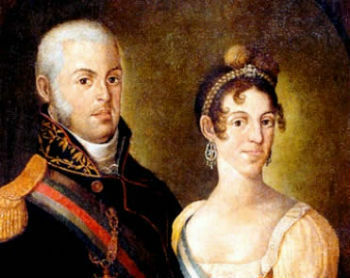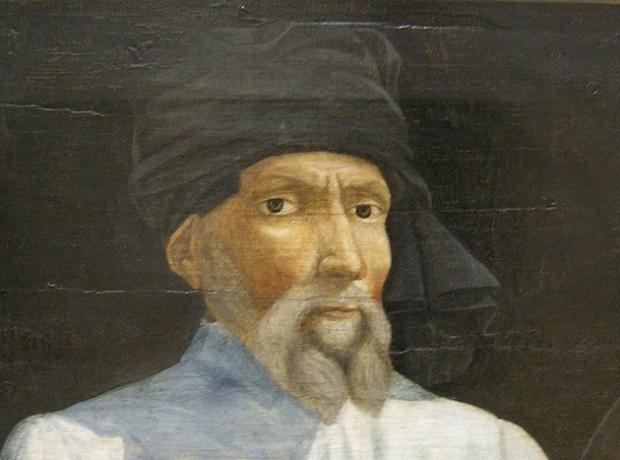Mrs. Carlota Joaquina de Bourbón born on April 25, 1775, Infanta de Espanha, was the daughter of King Dom Carlos IV and his wife, Queen Maria Luisa de Parma.
She learned languages, history, court etiquette and religion. She possessed extraordinary energy and throughout her life was active in Portuguese, Brazilian and Spanish politics.
She was the wife of Dom João VI and mother of the Emperor Dom Pedro I of Brazil.

Dona Carlota Joaquina pictured with the Dom João medallion.
Wedding
The marriage between the Portuguese prince and the Spanish Infanta was part of the project to bring the two kingdoms closer together. After all, it was advantageous for both countries to keep the peace through marriages.
At the age of ten, the Infanta Dona Carlota Joaquina leaves Madrid to marry Dom João. In turn, the sister of D. João, Dona Maria Ana Vitória, would marry the Spanish infant D. Gabriel.
The union would yield nine children, eight of whom reached adulthood.
Married at an early age, the marriage was never happy and D. Carlota Joaquina and D. João VI only fulfilled their protocol obligations. In any case, the children were born and raised in an environment of family and political tension.
In 1788, the eldest son of D. Maria I, D. José (Prince of Brazil), dies, and D. João is hailed as heir to the Portuguese throne. At this time, the mental health of Queen D. Maria already showed signs of being shaken; D. João assumed the regency of the overseas empire from 1792.
Carlota Joaquina has always been described as a very ugly person. She would be small, limp, and still had the marks of smallpox contracted in childhood on her face.
Learn more about the life of Dom João VI
Historical context
Meanwhile, Napoleon Bonaparte expands his empire beyond French borders. He negotiated with the Spanish king to invade Portugal through Spain and did so in 1807.
With the protection of the English squadron, the Portuguese Court leaves Lisbon on November 30, 1807. They arrived in Salvador in January 1808 and in Rio de Janeiro in March of the same year, where they would stay until 1821.
When the Portuguese court moved to Brazil, D. Carlota Joaquina settled in the neighborhood of Botafogo, in a private palace, with her daughters, while D. João occupied the Palace of São Cristóvão. So they met only when it was necessary.
From the palace in Botafogo, where D. Carlota lived, there is still the Chapel of Nossa Senhora da Piedade.
Read more about the coming of the Royal Family to Brazil.
Carlota Joaquina and Spanish America
Although he left Spain as a child, what is certain is that he never stopped keeping in touch with his Spanish relatives.
With the arrest of his brother, King D. Fernando VII, Dona Carlota Joaquina planned to proclaim himself regent of the Spanish colonies in America.
For this, she maintained contact with the Government Boards of different regions such as the Vice-Kingdom of Silver and the Vice-Kingdom of Peru. He enlisted the support of Admiral Sydney Smith to co-opt supporters for his purposes. D. João informed of his plans asked the British government to replace the said admiral.
Likewise, she received in Rio de Janeiro the Spanish envoy, General José Manuel de Goyeneche.
The officer sent Dona Carlota Joaquina's letters to the colonies and to the Junta de Sevilla. In this correspondence, she offered to be regent of the Spanish possessions in America while the King of Spain was imprisoned.
He found no support for his project neither in America nor in Spain. There, it was declared that only the regency of King Ferdinand VII in America was recognized, even though he was in prison.
Learn more about Independence of Spanish America.
Alliances with Spain
Despite the political friction, D. Carlota Joaquina continued to be active in politics through marital arrangements between her daughters and brothers.
Infant D. Maria Isabel de Portugal would marry her uncle, the Spanish King Dom Fernando VII and would become Queen of Spain.
On the same occasion, daughter D. Maria Francisca de Assis (1800-1834), would marry Infante D. Carlos, brother of D. Carlota, and after her death, with her other niece, D. Maria Thereza (1793-1874).
It is worth remembering that at this time, marriage between nephews and uncles was allowed through papal dispensation.
Back to Portugal

Dom João VI and Mrs. Carlota Joaquina
Dissatisfied with the permanence of the Brazilian Court in Brazil, people in the city of Porto began a series of protests that would culminate in the Porto Liberal Revolution.
On this occasion, the Portuguese demand that Dom João VI and the Court return to Portugal and that the monarch recognize the Constitution drawn up by the Cortes.
Meanwhile, his son Dom Pedro was left in Brazil and on September 7, 1822, he would break ties with Portugal by proclaiming the independence of Brazil.
The news of the return to Portugal left D. Carlota Joaquina was very happy because she was going back to Europe. However, the political situation on the continent had changed.
Upon arriving in Portugal, she refuses to sign the Constitution that limits the powers of monarchs. She also insists, unsuccessfully, that D. John VI, do the same.
In this way, through son D. Miguel, find a way to conquer power again. D's preference was notorious. Carlota Joaquina for her son D. Miguel in relation to D. Peter. Thus, she helps him to conspire against his own father in episodes known as Vilafrancada and Abrilada.
However, fearful that his wife would continue to conspire against his government, D. João VI sent her first to Quinta do Ramalhão and later to Queluz Palace. There, D. Carlota Joaquina remained practically closed until her death, on January 7, 1830.
Quiz of personalities who made history
Curiosities
- Three children of D. Carlota Joaquina ascended the throne: D. Pedro I, as emperor of Brazil and Pedro IV, king of Portugal. D. Miguel was also king of Portugal from 1828 to 1834 when he was defeated in a civil war by his brother Pedro. D. Maria Isabel of Portugal would be Queen Consort of Spain.
- Likewise, D. Isabel Maria was regent of Portugal for almost two years, after the death of D. João VI and takeover by D. Miguel.
- There is currently an attempt to rescue the historical figure of Dona Carlota Joaquina through her political performance.



